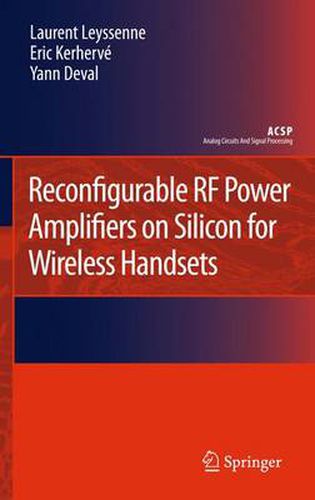Readings Newsletter
Become a Readings Member to make your shopping experience even easier.
Sign in or sign up for free!
You’re not far away from qualifying for FREE standard shipping within Australia
You’ve qualified for FREE standard shipping within Australia
The cart is loading…






This title is printed to order. This book may have been self-published. If so, we cannot guarantee the quality of the content. In the main most books will have gone through the editing process however some may not. We therefore suggest that you be aware of this before ordering this book. If in doubt check either the author or publisher’s details as we are unable to accept any returns unless they are faulty. Please contact us if you have any questions.
Reconfigurable RF Power Amplifiers on Silicon for Wireless Handsets is intended to designers and researchers who have to tackle the efficiency/linearity trade-off in modern RF transmitters so as to extend their battery lifetime. High data rate 3G/4G standards feature broad channel bandwidths, high dynamic range and critical envelope variations which generally forces the power amplifier (PA) to operate in a low efficiency backed-off regime. Classic efficiency enhancement techniques such as Envelope Elimination and Restoration reveal to be little compliant with handset-dedicated PA implementation due to their channel-bandwidth-limited behavior and their increased die area consumption and/or bill-of-material. The architectural advances that are proposed in this book circumvent these issues since they put the stress on low die-area /low power-consumption control circuitry. The advantages of silicon over III/V technologies are highlighted by several analogue signal processing techniques that can be implemented on-chip with a power amplifier. System-level and transistor-level simulations are combined to illustrate the principles of the proposed power adaptive solutions. Measurement on BICMOS demonstrators allows validating the functionality of dynamic linearity/efficiency management. In Reconfigurable RF Power Amplifiers on Silicon for Wireless Handsets, PA designers will find a review of technologies, architectures and theoretical formalisms (Volterra series…) that are traditionally related to PA design. Specific issues that one encounters in power amplifiers (such as thermal / memory effects, stability, VSWR sensitivity…) and the way of overcoming them are also extensively considered throughout this book.
$9.00 standard shipping within Australia
FREE standard shipping within Australia for orders over $100.00
Express & International shipping calculated at checkout
This title is printed to order. This book may have been self-published. If so, we cannot guarantee the quality of the content. In the main most books will have gone through the editing process however some may not. We therefore suggest that you be aware of this before ordering this book. If in doubt check either the author or publisher’s details as we are unable to accept any returns unless they are faulty. Please contact us if you have any questions.
Reconfigurable RF Power Amplifiers on Silicon for Wireless Handsets is intended to designers and researchers who have to tackle the efficiency/linearity trade-off in modern RF transmitters so as to extend their battery lifetime. High data rate 3G/4G standards feature broad channel bandwidths, high dynamic range and critical envelope variations which generally forces the power amplifier (PA) to operate in a low efficiency backed-off regime. Classic efficiency enhancement techniques such as Envelope Elimination and Restoration reveal to be little compliant with handset-dedicated PA implementation due to their channel-bandwidth-limited behavior and their increased die area consumption and/or bill-of-material. The architectural advances that are proposed in this book circumvent these issues since they put the stress on low die-area /low power-consumption control circuitry. The advantages of silicon over III/V technologies are highlighted by several analogue signal processing techniques that can be implemented on-chip with a power amplifier. System-level and transistor-level simulations are combined to illustrate the principles of the proposed power adaptive solutions. Measurement on BICMOS demonstrators allows validating the functionality of dynamic linearity/efficiency management. In Reconfigurable RF Power Amplifiers on Silicon for Wireless Handsets, PA designers will find a review of technologies, architectures and theoretical formalisms (Volterra series…) that are traditionally related to PA design. Specific issues that one encounters in power amplifiers (such as thermal / memory effects, stability, VSWR sensitivity…) and the way of overcoming them are also extensively considered throughout this book.